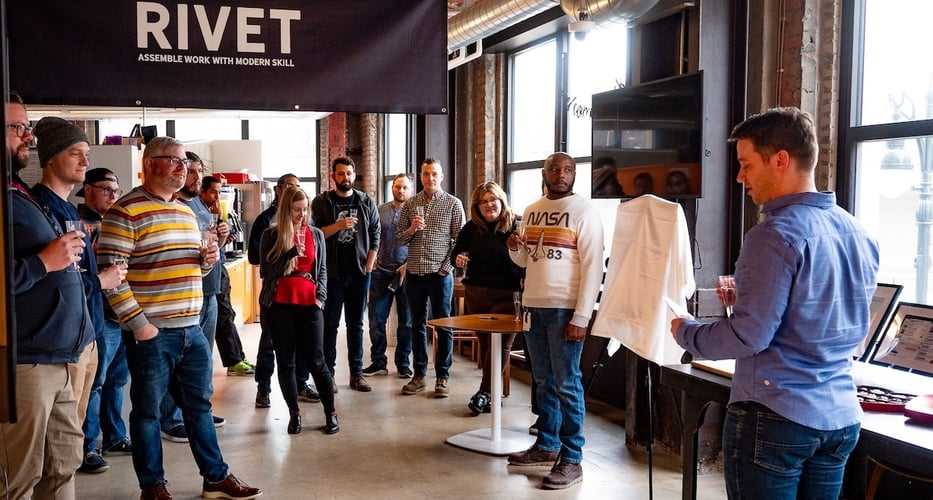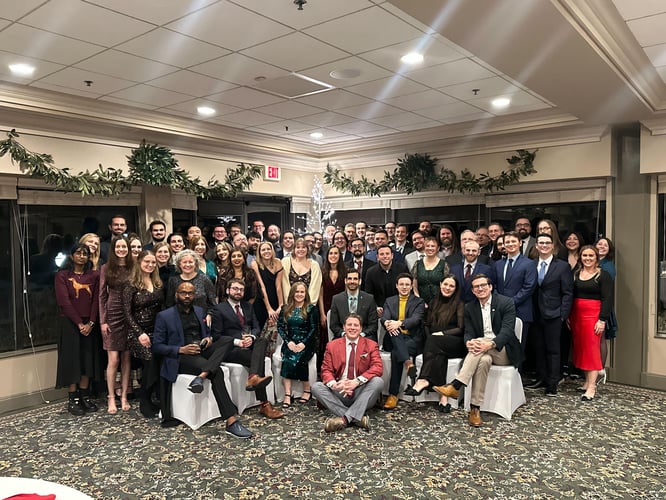Meditation makes people better leaders, and when done consistently can be more effective than any knowledge on leadership one could acquire. Hard stop.
If you are in a leadership position, nearly all acquired knowledge (including any degree on which you spent many tens of thousands of dollars) is obsolete the moment it’s acquired, given the pace of change today. By definition, leadership involves facing and navigating ambiguity and change and helping others to do the same, a task at which acquired knowledge, or even practice, produces outcomes only about 1% better than doing nothing at all. As Naval Ravikant, founder of AngelList, prolific angel investor and Twitter philosopher says, “there’s no skill called ‘business’” that you can learn.
Much better, then, to develop your ability to navigate change and uncertainty. Better to hone your ability to make good decisions, free from unconscious bias, and invest in your ability to connect with, understand, and lead your people. These are the traits of a successful leader today.
Those are also the results one can expect of meditation.

Three offerings of meditation
Leaders are often driven by attaining goals—by success. This makes meditation hard to navigate for some at first because, by its nature, meditation is about letting go. Any amount of chasing “good meditation” will only bring you farther away from the remarkable benefits that it can bring.
That said, if you haven’t already developed a practice and are wondering why anyone would invest in “sitting quietly not doing much” rather than checking another email off the list or attending leadership classes, allow me to suggest that one would choose meditation if one wanted to strengthen the following three attributes: Concentration. Equanimity. Insight.
Concentration:
— the action or power of focusing one’s attention or mental effort
It seems like anyone should be able to focus on something for a minute, without getting distracted by thought. It’s only a minute, right?
Neuroscientist Sam Harris offers an experiment, to test this:
See if you can stop thinking for the next 60 seconds. You can notice your breath, or listen to the birds, but do not let your attention be carried away by thought, any thought, even for an instant. Some of you will be so distracted by thought as to imagine that you succeeded. In fact, beginning meditators often think that they are able to concentrate on a single object, such as the breath, for minutes at a time, only to report after days or weeks of intensive practice that their attention is now carried away by thought every few seconds. This is actually progress. It takes a certain degree of concentration to even notice how distracted you are. Even if your life depended on it, you could not spend a full minute free of thought.
Meditation is, in essence, practicing focusing. Whether the object of meditation is the breath, a mantra, or even if you’re practicing objectless meditation like Shikantaza, you’re directly flexing your concentration muscle. And like any muscle, over time it gets get stronger.
Leadership is distracting, by nature. Between status updates with team members, strategy sessions, business development, fire dousing and the rest, most leaders can’t afford much time to dive deep into focused time, regardless of how important they know it to be (hint: it’s not just leaders). Being distracted and “busy” has become so ingrained in our culture that we glorify fundamentally impossible things like multitasking. But that really only serves as an emotional justification for our painful inability to focus.
The reality is, to make progress in anything requires focus, and the more consecutive moments of focus you can muster on a single item, the quicker progress happens. Particularly in leadership, when you must dive into a situation, focus, and then jump out quickly before diving back into another situation, the ability to focus deeply on a problem or situation at will without getting distracted is critical.
You may not make it a minute, but meditation is the most direct way to ratchet up your Concentration stamina.
Equanimity:
— mental calmness, composure, and evenness of temper, especially in a difficult situation
We notice things happening as we move throughout the world, but most of us don’t also notice the corresponding sensation in our body or thought in our mind. For every thing that happens in your external world, there is a corresponding internal marker, whether it be a body sensation, a thought or an emotion.
Whether conscious or not, most people spend most of their lives managing these sensations, thinking they’re operating within an external world. Two of the biggest triggers for people are change and uncertainty, which our mid- and post-COVID world has in spades. The world might trigger an emotion like dread (say your Controller says to you: “we need to talk”), which if unnoticed can literally color your entire reaction to the situation, and drive suboptimal outcomes that you look back on with regret. Not that I know anything about that.
Meditation gives us a space to see this mechanism in action. To literally watch the sensory nature of our world, and watch how those sensations trigger habitual reactions. To see dread for what it is: a mix of sensations, thoughts and emotions, none of which mean much at all despite their perceived intensity. And sitting still with our eyes closed, meditation offers the opportunity to practice experiencing these sensations without automatically reacting.
Through meditative practice, you develop your ability to experience thoughts/feelings/sensations as they are, without reacting to them, judging them, or needing to change or add to them. So that in situations of intense emotion, instead of making a reflexive decision you regret, you develop your ability to pause, let the feeling happen, and then act. You develop the power to remain calm in crazy situations, not because you’re not feeling the craziness, but because you’ve trained in how to manage it.
In other words, you develop Equanimity.
Insight:
— direct, experiential understanding into the true nature of things
You probably think you know the true nature of things already—that you live in reality. If so, you’re wrong.
Not because Elon Musk is right and we’re living in a computer simulation, but because your mind has created innumerable virtual realities to help it navigate the world, and then mistakes those abstractions for the real thing.
This is helpful in many cases. For example, I can type many words per minute on this keyboard because my mind has created a mental model of how words translate to letters and then to finger strokes. I don’t have to interact with the actual complexity of the keyboard, the electricity that powers it and the connections to the black pixels appearing on the screen (reality), nor do I want to. It’s useful to live in the reality of simply words showing up on the screen while my hands go on autopilot. We do this type of abstraction to everything in our world, thereby isolating ourselves from reality in a bubble of abstractions, which we interact with as if they are actually real. Much of the time it’s a superpower, without which society as we know it would not be possible.
But this process of abstracting reality can also prevent us from seeing truths that are right in front of us, and actively inhibit us from making good decisions. Such as if we develop an abstract model of Bob from accounting as reliable and happy, and relate to him as such all the way until he blindsides us with his two week notice. As Mark Twain said, “What gets us into trouble is not what we don’t know. It’s what we know for sure that just ain’t so.”
Ray Dalio, billionaire hedge fund owner, author of the amazing book Principles, and possibly the most intentional decision maker in the world, agrees, adding, “Most people make bad decisions because they’re so certain they’re right that they don’t allow themselves to see the better alternatives that exist.”
In other words, we interact with our mental models of reality as if they were real, and in doing so miss key aspects of a situation that, were we to see them, might change our perspective. Our version of reality has blind spots (if you’re still skeptical, try this experiment).
Dalio (unsurprisingly an avowed meditator himself) elaborates, calling out two key inhibitors to good decision making within our distorted version of reality: Ego and Blind Spots. Dalio said, “The two biggest barriers to good decision making are your ego and your blind spots. Together, they make it difficult for you to objectively see what is true about you and your circumstances and to make the best possible decisions by getting the most out of others. If you can understand how the machine that is the human brain works, you can understand why these barriers exist and how to adjust your behavior to make yourself happier, more effective, and better at interacting with others.”
To maximize our potential as leaders, we must develop the ability to discern between useful abstractions like the keyboard, and harmful ones like our ego or beliefs based on faulty and unexamined premises. This skill requires first the humility to admit our perception of reality is fundamentally inaccurate at virtually all times (useful sometimes, yes, but still wrong), and second the willingness and ability to dissect our perception into its parts to determine what is actually true or useful, and what is not.
Enter meditation.
Through meditation we learn to understand reality on reality’s terms, seeing our biases, beliefs and other mental landmines in action. Seeing the mechanistic nature of our thoughts first hand while meditating has the affect of loosening our attachment to them, and giving us the choice to not respond or react. Meditation is a direct path to understanding how the machine that is the human brain works.
One of the early insights gained by meditators is that one is not the same as one’s thoughts; in fact, it doesn’t take much meditation at all to learn that we don’t actually have much control over our thoughts at all. So when you get the thought that you should fire off that angry email, coupled with tension throughout your body and mind, it’s easier to see it for the meaningless sensation it is, one that has nothing whatsoever to do with you, and simply wait for it to pass. Or, once you see that you have a tendency toward outsized optimism in the face of risk, or an unreasonable fear around running out of money regardless of your balance sheet, or that you’re hiring your father over and over again to work out unresolved childhood issues, to name three examples that have nothing to do with anyone we know, you then have the choice to intentionally tare out those biases, and make related decisions consciously (easier said than done in some cases, surely, but worth it in every case).
This is Insight in the context of meditation. The ability to see reality as it is, not as you are, and in doing so position yourself to make better decisions, connect more authentically with your people, and lead more effectively.
OK I’m in. So now what?
Download an app
If you’re just getting started, download a meditation app. There’s no wrong way to meditate, but there are definitely ways that work better than others, and having a pro walk you through it is infinitely more efficient than simply sitting quietly and thinking about your breath. Like camera phones, the best meditation teacher is the one you have in your pocket.
I recommend Waking Up by Sam Harris. He cuts through a lot of the unnecessary stuff that can get lumped in with meditation and focuses strictly on the practical. Other options are Headspace (popular), Insight Timer (behemoth), Calm and more. But if you’re unsure, go Waking Up.
Find a teacher
If you’re past the app stage, there are thousands of types of meditation you can practice, and any number of teachers, past and present, who you can look to for guidance on deepening your practice. I’m an avid reader, and so have found myself influenced deeply by specific authors and books. Here’s a short list of books I’d recommend on the topic:
-
Meditation
-
Waking Up — Sam Harris
-
Mastering the Core Teachings of the Buddha — Daniel Ingram
-
The Myth of Freedom & Way of Meditation — Chogyam Trungpa
-
Faith: Trusting your own deepest experience — Sharon Salzberg
-
Be Here Now — Ram Dass
-
-
Contemplative Business
-
Reboot — Jerry Colonna
-
Conscious Business — Fred Kofman
-
The Active Life — Parker Palmer
-
Additionally, if you live in a major metro there are likely teachers who will work with you one on one as you deepen your practice. Finding someone like this is worth many, many books.. In Michigan, I primarily work with, and can vouch for:
-
Sokuzan, Abbot of the Sokukoji Buddhist Monestary in Battle Creek, who teaches a stripped down form of Zen meditation called Shikantaza.
-
Vincent Horn & Kenneth Folk, who each teach a modified version of the Practical Insight Meditation originally taught by Mahasi Sayadaw (not MI but 100% digital).
Find a community
According to the guy who wrote the book on creating successful habits, James Clear, “The key, if you want to build habits that last, is to join a group where the desired behavior is the normal behavior.”
People approach meditation as a private thing (especially since mental health is, unhelpfully, still taboo in western culture), and understandably fall off the wagon at a high percentage. Your chances of developing a sustainable habit increase dramatically if you surround yourself with like-minded folks with the same goals.
There are many meditation communities you can find via Google (typically called Sangha). Many are Buddhist, many are other traditions. Whatever your faith or lack thereof, I’ve found that many sects of Buddhism are very accessible, so don’t let the specificity of the tradition dissuade you.
Or, if you’d prefer to practice amongst a group of your business peers in a non-theistic setting, contact me about joining one of my private Meditation for Leaders groups called The Quieting.
As Ramana Maharshi said, “Wanting to reform the world without discovering one’s true self is like trying to cover the world with leather to avoid the pain of walking on stones and thorns. It is much simpler to wear shoes.”
The path to becoming a great leader is fraught with stones and thorns. Rather than reading book after book about where the stones and thorns are, meditate and make yourself some damn shoes.
About Ryan Vaughn:
 As a leadership coach to entrepreneurs, Ryan works with amazing humans every day to build the company of their dreams and grow into extraordinary leaders. He can do this uniquely well because he's been there.
As a leadership coach to entrepreneurs, Ryan works with amazing humans every day to build the company of their dreams and grow into extraordinary leaders. He can do this uniquely well because he's been there.
Ryan is a 3x founder/CEO, and has scaled to over 11-million users across 45 states, raised over $20m from leading VCs, built a team of nearly 100 world-class employees, and acquired or partnered with nearly a dozen companies.
And he knows about the lows, too—losing your biggest customer, the fear of missing payroll. He knows about depression, and wondering how you’ll survive.
He's here to help. If you're interested in accelerating your growth as a leader, visit ryanhvaughn.com. And if you liked this article, please subscribe to Second Mountain Startup, Ryan's popular weekly newsletter about the art of startup leadership.






.png?width=50&name=Erin%20Gregory%20(1).png)
